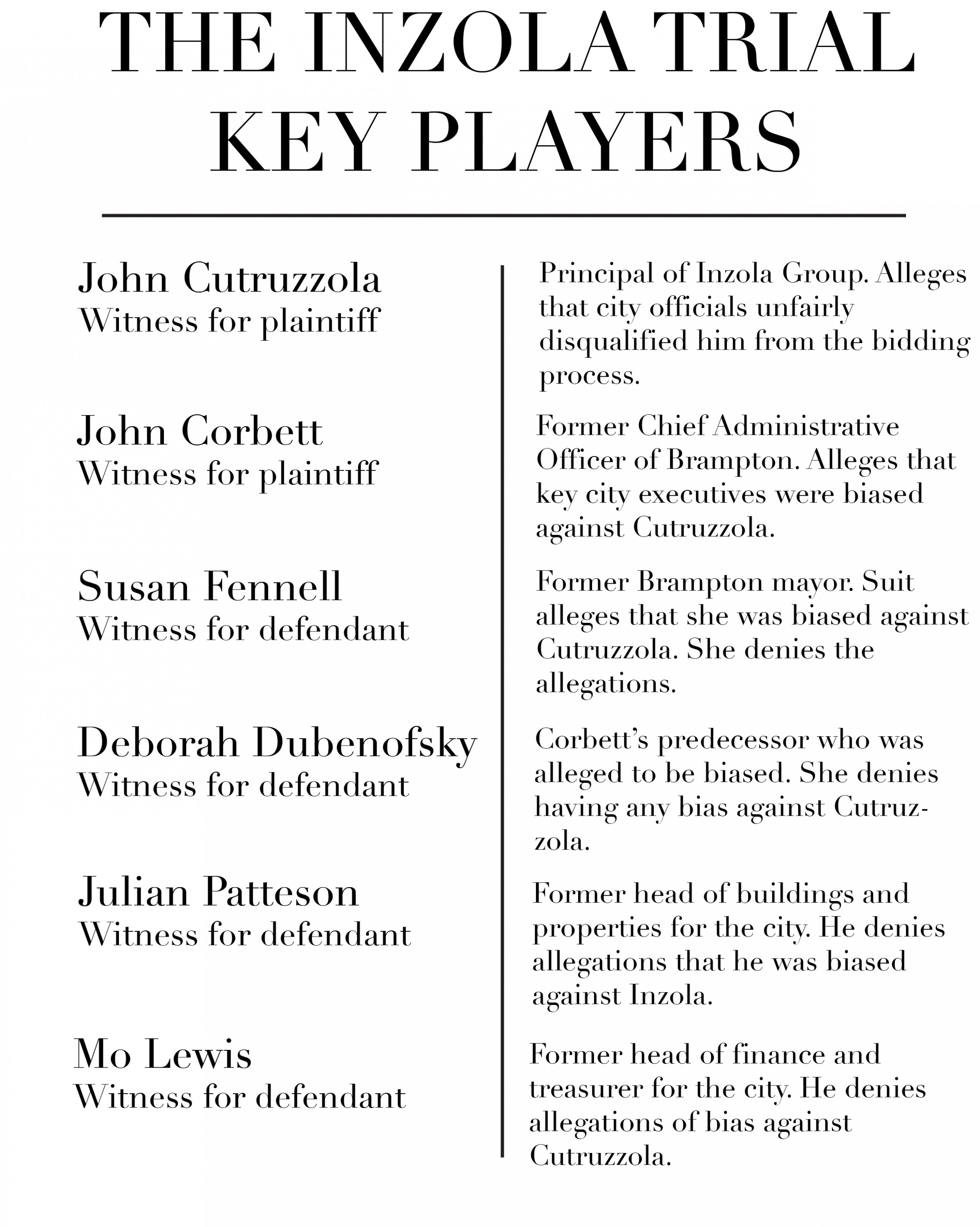
Company disqualified from multimillion-dollar development deal sums up claims of bias in $28.5M lawsuit
The City of Brampton wrongfully disqualified Inzola Group from the bidding process for a $500-million downtown development deal, carried out a biased process and should be on the hook for major damages, lawyers for the company claimed as part of closing arguments Wednesday in a $28.5-million lawsuit against the city.
Lawyers for Brampton are expected to get their turn at presenting final arguments in an Orangeville courtroom on Thursday, as the lawsuit, launched by Inzola in 2011, heads toward its close. The City and former mayor Susan Fennell have denied all allegations made in the suit.
 The details of the case have been expounded throughout a lengthy pretrial process and a trial that took place over the early summer, which included cross-examinations of key city staff members at the time that Inzola was disqualified, including the former city manager Deborah Dubenofsky; John Corbett, who succeeded her as the city’s top bureaucrat; former treasurer Mo Lewis; and former head of buildings and properties Julian Patteson.
The details of the case have been expounded throughout a lengthy pretrial process and a trial that took place over the early summer, which included cross-examinations of key city staff members at the time that Inzola was disqualified, including the former city manager Deborah Dubenofsky; John Corbett, who succeeded her as the city’s top bureaucrat; former treasurer Mo Lewis; and former head of buildings and properties Julian Patteson.
A central issue in the case is whether Inzola was indeed wrongfully disqualified from the bidding process for the downtown city hall expansion because staff members were biased against the company and held negative views of John Cutruzzola, its owner—and whether those views led the city to breach its contractual obligation to treat Inzola fairly and equally throughout the request for proposals (RFP) process.
The issue of fairness permeated the day of final submissions. Fairness is a critical element of general contract law. Put simply, in legal contracts and procurement deals, the issuer has an obligation to treat all respondents equally and to act in good faith.
In this case, Inzola claims the city breached the contract that was created when the construction firm inquired about responding to the city’s RFP. While no document was signed, Inzola’s lawyers claim that a “shared understanding” between the two sides was created when city staff, through reports and communications with Inzola, vowed that the bidding process would be fair and equal.
To back up their claims, Inzola’s lawyers presented a detailed final submission.
The creation of a contract
Stuart Svonkin, a lawyer representing Inzola, started the final submission with a cascading argument, beginning with the contract automatically created when the City of Brampton and Inzola Group began corresponding about the RFP the municipality launched for the city hall expansion project in 2009.
Svonkin put to the court that the city owed Inzola a duty to treat the company fairly and equally throughout the process and to handle its bid without bias.
Inzola’s suit alleges that certain senior staff members, along with then-mayor Susan Fennell, did not want the company to succeed in the procurement process, which used an approach that was new to Canada called “competitive dialogue.”
At issue is whether this contract did in fact exist in the absence of signed documents. The city’s own acknowledgment of its existence, once Inzola chose to participate in the RFP process, is a crucial piece of Inzola’s case.
Svonkin pointed out that in a letter sent to Inzola in 2011, the city threatened to sue the construction firm for breach of contract. The letter was sent months before Inzola filed its own lawsuit.
Svonkin said the city can’t turn around after the fact and claim that no contract existed.
“It’s a contract; it’s not some duty floating out in the air without any legal grounding,” he said. “This is a threat that is entirely framed in contractual terms.”
Having established the contract aspect, Inzola’s lawyers shifted to their next point, that being the breach of this contract, the crux of Inzola’s wrongful disqualification.
Unequal punishment
Lawyer David Chernos, also representing Inzola, dug into the city’s reasoning for the decision to disqualify Inzola from the bidding process. Chernos noted that the city points to a “breach of contract” by Inzola as the cause of its disqualification.
The alleged breach, Chernos said, referred to the confidentiality requirements and communication protocols laid out in the RFP document.
Inzola attempted to get clarification about the confidentiality requirements through the proper channels at the city back in 2010. The company was concerned that particular clauses included in the binding confidentiality agreement that was issued subsequent to the RFP would stop councillors from ever viewing Inzola’s proposal.
When the company didn’t get the answers it sought, Cutruzzola attempted to appear before an open session of council as a delegation. This attempt, and Cutruzzola’s eventual comments to the media about the RFP process, led the city to declare the company had breached no-contact requirements in the RFP meant to prevent lobbying.
“There is more than a sufficient body of evidence that the decision was biased."
David Chernos, lawyer representing Inzola Group
Chernos went on to poke holes in the city’s response to Inzola’s concerns about confidentiality. He called attention to an email from Lewis that, instead of responding to the concerns the company had raised, deemed Inzola’s questions “pure mischief making” and pointed to 20 clauses in the RFP that could potentially disqualify the company from bidding.
Chernos argued the response was unduly strong only because the questions were coming from Inzola, and not another respondent.
“They have the obligation to at least treat it fairly and seriously,” Chernos said.
He drew attention to what he described as a much more serious breach of the RFP process by Dominus, which was to become the successful bidder, that the city flat-out ignored. (Dominus is not named in the lawsuit and has said that it followed all rules of the process.)
In its final submission for the bidding process in December 2010, Dominus stated that it had secured a George Street property known as the First Choice lands. It was a requirement of the RFP that the successful bidder had to secure the property without the city’s assistance, but Chernos argued that requirement was not met.
The option on the land became an issue in the case, as evidence entered in the trial process showed the city later paid the $480,000 Dominus needed to acquire the option for the property, without council’s knowledge.
Chernos asserted that the inclusion of false or misleading information in the Dominus bid was a “material breach” of the RFP terms, and a much more serious breach than that of which the city accused Inzola. While Inzola was disqualified, no action was taken against Dominus.
“Not only to ignore it, but to actively mislead council, to conceal it,” Chernos said. “The evidence is unmistakable.”
Chernos tied the decision not to punish Dominus into Inzola’s final and most crucial assertion: that the City of Brampton and staff members were biased and did not want to award the contract for the development to Inzola.
‘Emotionally charged feelings’
Inzola’s lawyers also claimed that the disqualification came about due to extreme bias on the part of certain staff members.
“There is more than a sufficient body of evidence that the decision was biased,” Chernos told the court, calling the evidence on this point “overwhelming.”
He said several staff members–including Lewis, who made the eventual decision to disqualify Inzola–held “emotionally charged feelings” about the developer.
Corbett, who became Brampton’s chief administrative officer after the city declined to renew Dubenofsky’s contract, testified that negative attitudes toward Cutruzzola and the company were “pervasive” among the group of senior staffers charged with the selection process, and that a third party looking in from the outside would have had serious concerns that the process was unfairly slanted against Inzola.
Chernos pointed to minutes of a meeting held in March 2011, after the contract was awarded to Dominus, during which Lewis noted that “council sent a message to the community that Inzola is not the big guy in this town anymore.” He also referred to other statements and emails that showed a “negative predisposition toward Inzola.”
The bias, if accepted as a factor by the court, would essentially prove that the process was unfairly skewed against Inzola, Chernos argued.
Submit a correction about this story


